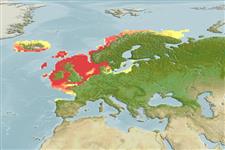Environment: milieu / climate zone / depth range / distribution range
Ecologia
marino demersale; oceanodromo (Ref. 51243); distribuzione batimetrica 10 - 200 m, usually 10 - 150 m (Ref. 35388). Temperate; 72°N - 43°N, 26°W - 45°E (Ref. 54592)
Northeast Atlantic: Bay of Biscay to the White Sea and off Iceland.
Length at first maturity / Size / Peso / Age
Maturity: Lm 29.3, range 20 - 30 cm
Max length : 65.0 cm TL maschio/sesso non determinato; (Ref. 9988); peso massimo pubblicato: 3.0 kg (Ref. 6112); Età massima riportata: 23 anni (Ref. 6112)
Small head and mouth. Body is oval. Skin is marbled and smooth. Lateral line almost straight, slight curve above the pectoral fin (Ref. 35388).
Lives most often on stony bottoms. Feeds on a variety of small invertebrates, but polychaetes seem to dominate. Apparently they do not feed in wintertime (Ref. 9900). Marketed fresh and frozen; eaten steamed, fried, broiled, microwaved and baked (Ref. 9988).
Spawning is mainly confined to depths of 55-91 m in the northwestern North Sea and commences at a minimum temperature of 6.5 °C in Scottish waters. Sex ratio is about 1:1, but females progressively predominate upon sexual maturity.
Vinnikov, K.A., R.C. Thomson and T.A. Munroe, 2018. Revised classification of the righteye flounders (Teleostei: Pleuronectidae) based on multilocus phylogeny with complete taxon sampling. Molecular phylogenetics and evolution, 125:147-162. (Ref. 122998)
IUCN Red List Status (Ref. 130435: Version 2024-1)
Threat to humans
Harmless
Human uses
Pesca: commerciale; Pesce da pesca sportiva: si; Acquario: Acquari pubblici
Strumenti
Special reports
Download XML
Fonti Internet
Estimates based on models
Preferred temperature (Ref.
123201): 7.1 - 12.5, mean 9.9 °C (based on 1310 cells).
Phylogenetic diversity index (Ref.
82804): PD
50 = 0.5625 [Uniqueness, from 0.5 = low to 2.0 = high].
Bayesian length-weight: a=0.00741 (0.00591 - 0.00930), b=3.09 (3.02 - 3.16), in cm total length, based on LWR estimates for this species (Ref.
93245).
Trophic level (Ref.
69278): 3.2 ±0.33 se; based on food items.
Resilienza (Ref.
120179): Medio, tempo minimo di raddoppiamento della popolazione 1.4 - 4.4 anni (K=0.08-0.42; tm=3-6; tmax=23).
Prior r = 0.71, 95% CL = 0.47 - 1.07, Based on 1 full stock assessment.
Fishing Vulnerability (Ref.
59153): Moderate to high vulnerability (51 of 100).
Climate Vulnerability (Ref.
125649): Low to moderate vulnerability (29 of 100).
Nutrients (Ref.
124155): Calcium = 20.4 [11.3, 39.5] mg/100g; Iron = 0.237 [0.134, 0.434] mg/100g; Protein = 17 [15, 19] %; Omega3 = 0.301 [0.150, 0.610] g/100g; Selenium = 18.1 [9.7, 37.5] μg/100g; VitaminA = 7.6 [1.8, 30.7] μg/100g; Zinc = 0.377 [0.264, 0.576] mg/100g (wet weight);
